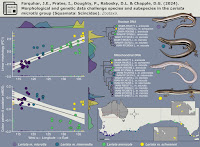 |
| Morphological and Genetic Data challenge Species and Subspecies in the Lerista microtis group (Squamata: ) in Farquhar, Prates, Doughty, Rabosky et Chapple, 2024. |
Abstract
The subspecies rank has been widely applied by taxonomists to capture infraspecific variation within the Linnaean classification system. Many subspecies described throughout the 20th century were recognised largely based on perceived variation in single morphological characters yet have since been found not to correspond to separately evolving population lineages, thus requiring synonymy or elevation to full species under lineage-based views of species. These modern lineage-based taxonomic resolutions have resulted from a combination of new molecular genetic techniques, improved geographical sampling of specimens, and more sophisticated analyses of morphological variation (e.g., statistical assessments rather than solely univariate descriptive ones). Here, we revisit the current taxonomic arrangement of species-level and subspecific taxa in the Lerista microtis (Gray) group, which is distributed along a narrow ~2000 km strip on the southern coast of Australia. From specimens of the L. microtis group, an additional species (Lerista arenicola) and two additional subspecies (L. m. intermedia and L. m. schwaneri) were described. We collected data on mensural, meristic, and colour pattern characters to explore morpho-spatial relationships among these taxa. Although our morphological analyses revealed some distinctiveness among specimens from locations assigned to each taxon, this variation is continuous along Australia’s southern coastline, assuming the form of a geographic cline rather than discrete forms. For many characters, however, spatial patterns were inconsistent with the original descriptions, particularly of the subspecies. Moreover, analysis of genome wide restriction-associated DNA loci revealed multiple instances of paraphyly among taxa, with phylogenetic clustering of specimens assigned to distinct species and subspecies. These emerging patterns provide no support for L. arenicola as a species evolving separately from L. microtis. Additionally, our findings challenge the presumed distinctiveness and coherence of the three subspecies of L. microtis. We thus synonymise L. arenicola and the L. microtis subspecies with L. microtis and provide a redescription of a single yet morphologically variable species—an arrangement that best reflects evolutionary history and the continuous nature of morphological variation across space.
Squamata, Australia, clinal variation, colour pattern, mitochondrial and nuclear DNA, Reptilia, south-coast five-toed slider, subspecies, taxonomy
Lerista microtis
Jules E. Farquhar, Ivan Prates, Paul Doughty, Daniel L. Rabosky and David G. Chapple. 2024. Morphological and Genetic Data challenge Species and Subspecies in the Lerista microtis group (Squamata: Scincidae). Zootaxa. 5437(3); 336-362. DOI: 10.11646/zootaxa.5437.3.2


